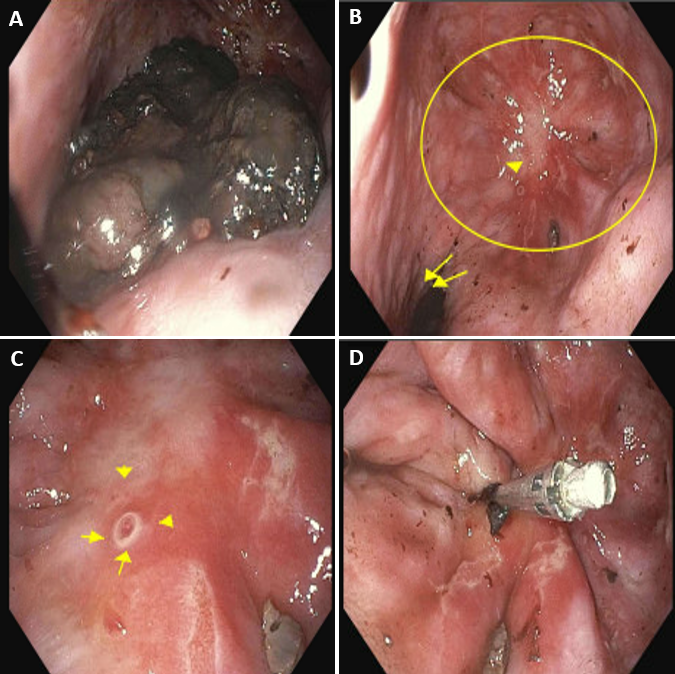Sunday Poster Session
Category: GI Bleeding
P0964 - A Perilous Pouch: An Epiphrenic Esophageal Diverticulum as a Rare Cause of Upper Gastrointestinal Bleeding
Sunday, October 26, 2025
3:30 PM - 7:00 PM PDT
Location: Exhibit Hall

Hobie L. Hughes, DO (he/him/his)
Thomas Hospital
Fairhope, AL
Presenting Author(s)
Award: ACG Presidential Poster Award
Hobie L. Hughes, DO1, Lauren Healey, DO2, Matthew Eves, MD1, Jonathan Francis, MD1, Nathaniel Winstead, MD, MSPH, FACG1
1Thomas Hospital, Fairhope, AL; 2University of South Alabama, Mobile, AL
Introduction: Acute gastrointestinal (GI) bleeding is one of the most common reasons for hospitalization in the Unites States. The location of GI bleeding is nearly equivalent between upper and lower GI sources. The most common causes of upper GI bleeding include: peptic ulcers, gastroduodenal erosions, esophagitis/gastritis, varices, Mallory-Weiss tears, and vascular malformations. Epiphrenic diverticula (ED) are rare outpouchings involving the distal esophagus and are often associated with esophageal motility disorders. ED are infrequent causes of significant upper GI bleeding with an estimated occurrence of 1 per 500,000 people per year with only a few documented cases of massive hemorrhage requiring intervention.
Case Description/
Methods: An 82-year-old female presented for evaluation of progressive weakness, fatigue, and altered mentation for several days. Her medical history was significant for a small hiatal hernia and intermittent dysphagia. Her initial hemoglobin was 7.7 g/dL on arrival and quickly dropped to 6.5 g/dL. Her family denied any history of hematochezia or melena, but did admit to intermittent episodes of coffee-ground emesis over the past week. The patient underwent an esophagogastroduodenoscopy (EGD) which showed a large blood clot burden in the distal esophagus. After successful removal of the clot burden, there was a large-based epiphrenic diverticulum noted at the gastroesophageal junction with a visible vessel as well as evidence of a nipple sign indicating recent bleeding with a high risk for rebleeding. A single hemostatic clip was placed. Additional EGD findings included moderate, diffuse gastric inflammation with erosions and friability as well as a Hill Grade III hiatal hernia.
Discussion: Epiphrenic diverticula are rare outpouchings of the distal esophagus, often associated with esophageal motility disorders, and are infrequent causes of upper GI bleeding. ED are rarely symptomatic, however symptoms can include dysphagia, regurgitation, and chest pain. ED are a rare source of upper GI bleeding but should remain a part of the differential, especially in elderly patients with a history of dysphagia or esophageal motility disorders. A high index of suspicion along with a low threshold for intervention should be maintained throughout the hospital course given that ED typically require either endoscopic or surgical intervention for identification as well as achievement of hemostasis.

Figure: A: Upper GI Tract Diverticulum with large clot
B: GE Junction (double arrows) with large based diverticulum (circle) with visible vessel (single arrow)
C: Base of large esophageal diverticulum with nipple sign
D: Status post clip placement
Disclosures:
Hobie Hughes indicated no relevant financial relationships.
Lauren Healey indicated no relevant financial relationships.
Matthew Eves indicated no relevant financial relationships.
Jonathan Francis indicated no relevant financial relationships.
Nathaniel Winstead indicated no relevant financial relationships.
Hobie L. Hughes, DO1, Lauren Healey, DO2, Matthew Eves, MD1, Jonathan Francis, MD1, Nathaniel Winstead, MD, MSPH, FACG1. P0964 - A Perilous Pouch: An Epiphrenic Esophageal Diverticulum as a Rare Cause of Upper Gastrointestinal Bleeding, ACG 2025 Annual Scientific Meeting Abstracts. Phoenix, AZ: American College of Gastroenterology.
Hobie L. Hughes, DO1, Lauren Healey, DO2, Matthew Eves, MD1, Jonathan Francis, MD1, Nathaniel Winstead, MD, MSPH, FACG1
1Thomas Hospital, Fairhope, AL; 2University of South Alabama, Mobile, AL
Introduction: Acute gastrointestinal (GI) bleeding is one of the most common reasons for hospitalization in the Unites States. The location of GI bleeding is nearly equivalent between upper and lower GI sources. The most common causes of upper GI bleeding include: peptic ulcers, gastroduodenal erosions, esophagitis/gastritis, varices, Mallory-Weiss tears, and vascular malformations. Epiphrenic diverticula (ED) are rare outpouchings involving the distal esophagus and are often associated with esophageal motility disorders. ED are infrequent causes of significant upper GI bleeding with an estimated occurrence of 1 per 500,000 people per year with only a few documented cases of massive hemorrhage requiring intervention.
Case Description/
Methods: An 82-year-old female presented for evaluation of progressive weakness, fatigue, and altered mentation for several days. Her medical history was significant for a small hiatal hernia and intermittent dysphagia. Her initial hemoglobin was 7.7 g/dL on arrival and quickly dropped to 6.5 g/dL. Her family denied any history of hematochezia or melena, but did admit to intermittent episodes of coffee-ground emesis over the past week. The patient underwent an esophagogastroduodenoscopy (EGD) which showed a large blood clot burden in the distal esophagus. After successful removal of the clot burden, there was a large-based epiphrenic diverticulum noted at the gastroesophageal junction with a visible vessel as well as evidence of a nipple sign indicating recent bleeding with a high risk for rebleeding. A single hemostatic clip was placed. Additional EGD findings included moderate, diffuse gastric inflammation with erosions and friability as well as a Hill Grade III hiatal hernia.
Discussion: Epiphrenic diverticula are rare outpouchings of the distal esophagus, often associated with esophageal motility disorders, and are infrequent causes of upper GI bleeding. ED are rarely symptomatic, however symptoms can include dysphagia, regurgitation, and chest pain. ED are a rare source of upper GI bleeding but should remain a part of the differential, especially in elderly patients with a history of dysphagia or esophageal motility disorders. A high index of suspicion along with a low threshold for intervention should be maintained throughout the hospital course given that ED typically require either endoscopic or surgical intervention for identification as well as achievement of hemostasis.

Figure: A: Upper GI Tract Diverticulum with large clot
B: GE Junction (double arrows) with large based diverticulum (circle) with visible vessel (single arrow)
C: Base of large esophageal diverticulum with nipple sign
D: Status post clip placement
Disclosures:
Hobie Hughes indicated no relevant financial relationships.
Lauren Healey indicated no relevant financial relationships.
Matthew Eves indicated no relevant financial relationships.
Jonathan Francis indicated no relevant financial relationships.
Nathaniel Winstead indicated no relevant financial relationships.
Hobie L. Hughes, DO1, Lauren Healey, DO2, Matthew Eves, MD1, Jonathan Francis, MD1, Nathaniel Winstead, MD, MSPH, FACG1. P0964 - A Perilous Pouch: An Epiphrenic Esophageal Diverticulum as a Rare Cause of Upper Gastrointestinal Bleeding, ACG 2025 Annual Scientific Meeting Abstracts. Phoenix, AZ: American College of Gastroenterology.


